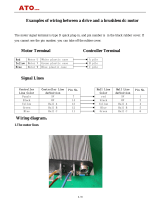
Small Engine Reference Design User Manual, Rev. 3.0
10 Freescale Semiconductor
System Setup
The best and safest way to begin developing an application for engine control is to work with a simulated
engine system. This reduces risk and development time by not having to focus on fuel related safety
concerns when trying to solve complex applications issues that arise. Developing with a simulated engine
system engine begins by selecting components that are similar or identical to the actual components on
the engine. For many of the loads, these can be the exact same components. In some cases, loads can
be replaced by a lesser expensive relay or a light. Relays work well for high power loads with dynamic
operating frequencies such as ignition and injectors. In those cases, the sound of the relay actuation is
beneficial to validate behavior during low speed testing. Other loads work better with lights or LEDs.
These are more simple loads that are simply controlled as on or off for long periods of time. Some loads
will require the actual load to test, such as an idle speed motor.
Perhaps the most challenging part of the system to simulate is engine position. Two core technologies
are used to sense engine position: variable reluctance sensors (VRS) and Hall Effect sensors. The
majority of production engines use a VRS for engine position. The advantage with the VRS is cost, while
a Hall Effect sensor provides a cleaner output signal. Both types are supported on the ECU. The default
configuration is for VRS. Use the schematic to identify the components to remove and populate for using
a Hall Effect sensor.
With respect to creating a simulated engine environment, engine position is the fundamental element.
Simulating the rotation of the engine can be done in two ways, virtual and physical simulation. A virtual
simulation involves a digital re-creation of the spinning crankshaft signal. This is best done by reproducing
a Hall Effect Sensor type of output, but there are options for a VRS. Using a different ECU, such as a
basic development board for a Freescale MCU, software can be written to create a the missing tooth
output pattern that is produced by a rotating engine using a Hall Effect Sensor. Such programs have
already been written for varying degrees of Freescale MCUs. The TOOTHGEN function is a part of a
library of functions for the MPC55xx products that have the eTPU peripheral.(ref1) Using a development
tool for such a product can allow the creation of a simulated engine position signal. For a VRS, options
for a virtual simulation include a combination of PC software with simple custom hardware. Do it yourself
(DIY) web sites, such as those for the Mega Squirt products, provide detailed instructions for building your
own circuit and provide PC software that can control the generation of the VRS signal based on a
simulated signal. (ref2)
While the concept of a virtual simulated engine position signal is very attractive, it lacks fundamental
characteristics that come with actual crankshaft of an engine. Since a virtual signal is typically generated
by a digital computer, it usually does not account for the real world imperfections of an engine.
Specifically, the timing pulses produced by a virtual signal are perfect. While this is a good on paper or
visually on a screen, the imperfections in the motion due to production tolerance and jerk associated with
cylinder compression lead to a rotation pattern that is not perfect. As a step in the right direction, a
physical simulated engine position signal can be used. This type of setup can take advantage of VRS or
Hall Effect Sensors and produce a signal that has more realistic characteristics to a real engine. A simple
and effective way to make a physical simulation is to mount an engine flywheel containing the position
teeth to a small electric motor. This creates a tool known as a spin bench. Using an electric motor and the
actual flywheel allows simple control of the engine speed while adding real world conditions for changes
in the actual time between position teeth. While the strong variations related to compression and
combustion are not present, the spin bench does allow transitions to and from a stopped engine and
provide teeth that are representative of the actual engine that the application is being developed for.
Figure 8 shows an example of a spin bench using a production flywheel and VRS from a small motorbike.




















